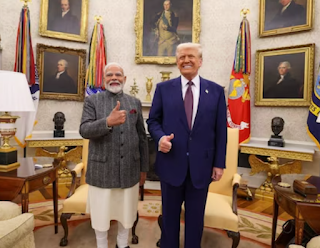Prime Minister Narendra Modi's visit to the United States during Donald Trump’s second presidential term has been hailed as a significant diplomatic and strategic success. Despite initial concerns about Trump’s announcement of reciprocal tariffs just before the meeting, Modi managed to navigate the discussions skillfully, securing key agreements in defense, trade, and energy cooperation. Leading American foreign policy experts, including Ashley J. Tellis and Lisa Curtis, have commended Modi’s ability to engage with Trump effectively, reinforcing the strength of U.S.-India ties.
Tellis, a seasoned expert in U.S. foreign and defense policy, emphasized that Modi's primary objective was to solidify India’s standing as a crucial American partner while mitigating potential trade-related frictions with Trump. Given Trump’s well-known focus on tariffs and trade imbalances, Modi’s task was far from easy. However, his strategic diplomacy and ability to establish a personal rapport with Trump played a vital role in achieving a favorable outcome. Tellis described the visit as "Modi Makes Magic," noting that disarming a personality like Trump is no small feat, yet Modi successfully positioned India as a key ally despite trade tensions.
One of the major highlights of the visit was the defense cooperation between the two nations. The United States offered India its state-of-the-art F-35 fighter jets, a move that underscores Washington’s commitment to strengthening India's defense capabilities. The F-35, known for its stealth and advanced operational technology, would mark a significant enhancement in India’s air power. However, given past delays in the delivery of GE F404 engines for the Tejas fighter jet, India is expected to assess the offer with caution. Tellis noted that the offer of such high-end military technology symbolizes the growing strategic trust between the two countries.
Beyond defense, the meeting also yielded key agreements in trade and energy. The two nations set an ambitious bilateral trade target of $500 billion by 2030, signaling long-term economic cooperation. Additionally, India committed to increasing its imports of U.S. oil and gas, which would not only help bridge the nearly $50 billion trade deficit but also enhance energy security. This move aligns with Modi's vision of reducing India's dependence on traditional oil suppliers and diversifying energy partnerships.
Lisa Curtis, a national security expert who served in Trump’s first administration, highlighted that the timing of Modi’s visit—just weeks into Trump’s second term—reflected the importance the U.S. places on its relationship with India. She pointed out that both leaders share a strong nationalist approach to governance, prioritizing their respective countries' interests while maintaining mutual respect and admiration. This was evident in Modi’s creative reinterpretation of Trump’s famous "MAGA" (Make America Great Again) slogan, adapting it to "MIGA" (Make India Great Again). Modi further expanded on this idea, stating that when the U.S. and India work together, their collaboration becomes a "MEGA" partnership for prosperity.
While Trump's announcement of reciprocal tariffs before the meeting initially raised concerns, experts have interpreted it as a negotiation strategy rather than a direct slight toward India. Tellis explained that Trump operates in a manner where he applies pressure early in discussions to extract better deals. Curtis added that this pattern has been observed in Trump’s dealings with various nations, suggesting that India should not view the move as an embarrassment but rather as part of Trump’s broader economic strategy. The agreements reached during the meeting indicate that Modi successfully found common ground with Trump, allowing for further negotiations on trade-related disputes.
However, challenges remain, particularly in defense procurement. While the offer of F-35 fighter jets is a strong indication of strategic trust, India's concerns regarding delays in past defense deals cannot be ignored. Curtis acknowledged that both India and the U.S. have bureaucratic hurdles that slow down such agreements. She cited the example of the MQ-9 drone deal, which took seven years to finalize despite being approved early on. Given these challenges, India is likely to scrutinize the details of the F-35 offer before making a final decision.
Overall, Modi’s visit to the U.S. has been seen as a major diplomatic win, reinforcing India's position as a key strategic ally of the United States. The agreements reached in defense, trade, and energy cooperation have set the stage for deeper collaboration between the two nations. While certain hurdles remain, experts are optimistic that the U.S.-India relationship will continue to evolve positively, with both nations working closely to address shared challenges and capitalize on mutual opportunities.



